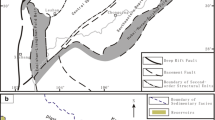Abstract
Carbonate cement is the most important authigenic mineral in M reservoir sandstone reservoir of Jianquanzi Formation in Jiuxi Basin, and its content and distribution form are the main factors affecting reservoir quality. Through mineralogy, petrology and geochemical analysis, it is concluded that the carbonate cements in this area are mainly composed of iron-free dolomite and calcite, and are often developed in the form of ring-side and speckle. The content of carbonate cement ranged from 2.11% to 56.39%, with an average of 12.93%. Microzone observation shows that the iron-free microcrystalline dolomite cements are distributed outside the particles and cover the whole particles, and they are mainly formed from cogenesis to the early stage of premorphic rock. The iron-free dolomite cements formed in the early stage increase the mechanical strength and compact-resistance of the rocks, which is beneficial to the development of the reservoirs in the study area. Speckle like sparry calcite cement mainly grows along the pore space and finally occupies the entire pore space. It is the chemical precipitation product in the late diagenesis, which is unfavorable to the development of reservoir. The value of δ18O (PDB) is −11.14‰ ~ −3.25‰, and the value of δ13C (PDB) is −7.32‰ ~ −0.42‰, indicating that the carbonate cement in this area comes from the brachywater environment and is related to the dissolvation-deposition process and is of chemical origin. The δ13C isotope is generally negative in the speck distribution of carbonate cements, which may be due to the addition of light organic carbon in the M oil layer, and the calcium ion produced by the organic acid produced by decarboxylation of organic matter under high temperature and pressure and the reaction with clay minerals provides the Source of Ca2+ for diagenetic diagnosis of carbonate cements. The study also shows that carbonate cementation may be one of the important factors that make the sandstone reservoir physical property of M oil group worse, and the porosity loss rate of M oil group is up to 16% due to carbonate cementation. The research results on the characteristics and formation mechanism of carbonate cements provide key parameters for quantitative evaluation of reservoirs and experimental support for acidification and stimulation measures.
Access this chapter
Tax calculation will be finalised at checkout
Purchases are for personal use only
Similar content being viewed by others
References
Zhang, M., Huang, S., Wu, Z., Wu, S., Hu, Z., et al.: Carbonate cements and their formation mechanism in Palaeogene sandstones of Lishuisag, East China Sea basin. J. Chengdu Univ. Technol. (Sci. Technol. Ed.) 34(3), 259–266 (2007)
Carlos, R., Rafaela, M., Karl, R., et al.: Facies-related diagenesis and multiphase siderite cementation and dissolution in the reservoirs and stones of the Khatatba Formation·Egypt western desert. J. Sediment. Res. 71(3), 459–472 (2001)
Xu, B., Lu, B.: The study of diagenetic carbonate in siliciclastic rock and it’s control on the reservoir. Acta Sedimentol. Sin. 12(3), 56–66 (1994)
Kantorowicz, J.D., Bryant, I.D., Dawans, J.M.: Controls on the geometry and distribution of carbonate cements in Jurassic sandstones: Bridport Sands, southern England and Viking Group, Troll Field, Norway. Geol. Soc. London, 103–118 (1987). Marshall JD. Diagenesis of sedimentary sequences. London, Special Publication No. 36
Hu, Z.: Calcitecements in Upper Palaeozoics and reservoir of Ordos Basin. Acta Petrolei Sinica 23(4), 40–43 (2003)
Liu, D., Sun, X., Li, Z., et al.: Carbon and oxygen isotope analysis of fluid inclusions in Ordovician carbonate veins of Ordos Basin. Acta Petrolei Sinica 28(3), 68–79 (2007)
Macaulay, C.I., Haszeine, R.S., Fallick, A.E.: Distribution chemistry isotopic composition and origin of diagenetic carbonates: Magnus Sandstone, North Sea. J. Sediment. Petrol. 63, 33–43 (1993)
Mostafa, F., Harrison, T.M., Grove, M.: Insitu stable isotopic evidence for protracted and complex carbonate cementation in a petroleum reservoir, North Coles Levee, San Joaquin basin, California, USA. J. Sediment. Res. 71(3), 444–458 (2001)
Keith, M.L., Weber, J.N.: Carbon and oxygen isotopic composition of selected limestones and fossils. Geochim. Cosmochim. Acta·28, 1786–1816 (1964)
Deng, H., Qian, K.: Sedimentary geochemistry and environment analysis, pp. 34–35. Ganshu Science and Technology Publishing House, Langzhou (1993). (in Chinese)
Tan, H., Yu, S.: Present situation and future development of elemental geochemistry in the study of lake sediments evolution. J. Salt Lake Res. 7(3), 58–65 (1999). (in Chinese with English abstract)
Liu, G.: The application of geochemical analysis to the study of sedimentary environment of Qianjiang Formation in Qianjiang depression. Acta Geosci. Sin. 28(4), 335–340 (2007). (in Chinese with English abstract)
Xie, Y., Fu, M., Chen, Q., Zhang, S., et al.: Controlling factors of reservoir development under high temperature in an extensional basin: a case study from Wenchang A Sag in Pearl River Estuary Basin. Geol. Sci. Technol. Inf. 35(1), 59–67 (2016)
Yao, J., Wang, Q., Zhang, R., Tang, J., et al.: Origin and spatial distribution of carbonate cements in Yanchang Fm. (Triassic) sandstones within the lacustrine center of Ordos Basin, NW China. Nat. Gas Geosci. 35(1), 59–67 (2016)
Sheng, J., Sun, W., Xie, T., Zhang, R., Zhao, T., et al.: Diagenesis of He-8 reservoir and its quantitative analysis of porosity evolution model in Southeast Sulige gas field. Geol. Sci. Technol. Inf. 34(1), 20–27 (2014)
Author information
Authors and Affiliations
Corresponding author
Editor information
Editors and Affiliations
Rights and permissions
Copyright information
© 2022 The Author(s), under exclusive license to Springer Nature Singapore Pte Ltd.
About this paper
Cite this paper
Gou, Y., Zhang, X., Li, Y., Zhang, S., Jiumei, Q. (2022). Carbonate Cement Distribution and Carbon and Oxygen Isotope Enrichment Characteristics of Sandstone Reservoirs in M Oil Formation in Shiyougou Oilfield. In: Lin, J. (eds) Proceedings of the International Field Exploration and Development Conference 2021. IFEDC 2021. Springer Series in Geomechanics and Geoengineering. Springer, Singapore. https://doi.org/10.1007/978-981-19-2149-0_207
Download citation
DOI: https://doi.org/10.1007/978-981-19-2149-0_207
Published:
Publisher Name: Springer, Singapore
Print ISBN: 978-981-19-2148-3
Online ISBN: 978-981-19-2149-0
eBook Packages: Earth and Environmental ScienceEarth and Environmental Science (R0)




